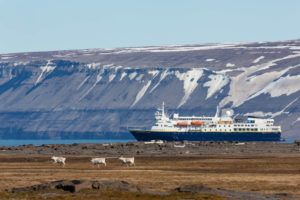The Arctic Circle was surprisingly warm. Zoe Lansbury, a government major at The University of Texas at Austin, was told to pack no fewer than four layers. Thermal underwear, a fleece shirt, a wool sweater and a waterproof jacket that covered her hips. She diligently went in search of all of the necessary gear to bring for her summer trip aboard an Arctic observation vessel. Inside the boat she felt a steady chill and saw the rest of her cohort suiting up for their first steps into the frigid tundra air. She readied herself, but standing on the navy blue hull of the ship, her breath did not freeze over. “I had all of the layers on,” Lansbury said. “I thought I was going to die because I was so hot.”
Lansbury was one of two UT Austin undergrads to spend their summer scoping out the climate crisis in person. She and studio art major Seyi Odufuye joined ClimateForce: Arctic 2019, a 12-day expedition to Norway and the Arctic. The 90-person trip was meant to inspire conversations among industry, academic and community leaders about the changing climate. Leading the excursion was famous environmentalist and adventurer Robert Swan — the first person to walk to both the North and South poles.
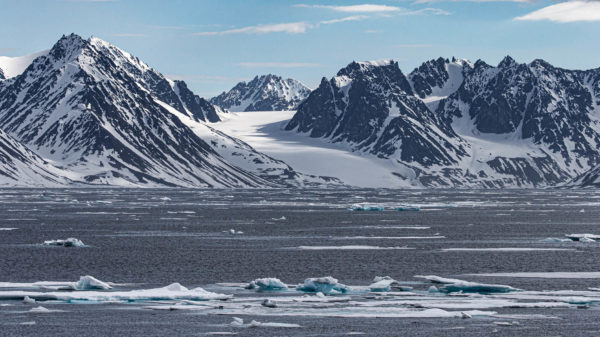
In 1985, Swan’s light blue eyes turned a pale gray. Upon returning from an expedition to Antarctica, he realized that he had just spent 70 days walking under the newly discovered hole in the ozone layer. The sun’s rays had changed the pigmentation of his eyes and skin. With no previous interest in environmentalism, Swan then dedicated his life to gaining protections for the polar regions by 2041, when legislation that prevents Antarctic mining expires.
In fall 2018, Swan visited Jay Banner and Dave Allen’s “Sustaining a Planet” UT Signature Course. Sitting in the classroom were Lansbury and Odufuye. Inspired by his message, they decided to apply and fundraise to join him on his next voyage. As sophomores, Lansbury and Odufuye were among the youngest on the expedition — they represented UT Austin along with two research scientists and one staff member. Out of the 26 countries present on the expedition, UT had the only official university group.

A large portion of the trip centered around Svalbard, a Norwegian archipelago in the Arctic Ocean. Although moderate temperatures during Norwegian summers are not uncommon, the effect of the climate crisis in Svalbard is undeniable. Surface air temperatures in the region are increasing at twice the global rate. Average annual temperatures have risen by 7.2 degrees Fahrenheit since 1970, according to the Norwegian Center for Climate Services.
Svalbard is famous for grand northern wildlife. Lansbury had expected to see reindeer, which are native to the region. Just a few weeks after the voyage ended, the Norwegian Polar Institute reported that 200 reindeer carcasses were found in Svalbard this year. Researchers attributed the unusually high death toll to the changing climate. “The animals starve and can die, and it is the youngest and weakest animals that succumb first,” the institute told CBS News. “We’d see an elderly group of only three, which isn’t a lot,” Lansbury said.
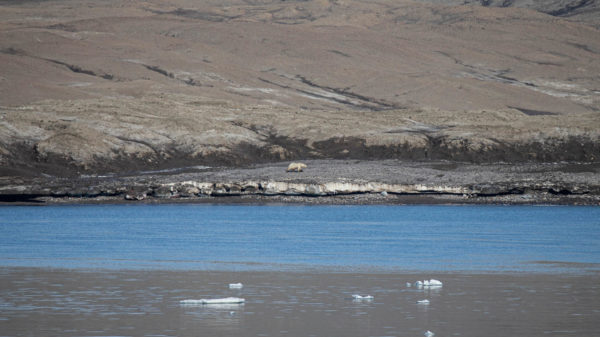
You have to be intentional about keeping that inspiration going. I have to constantly remind myself: I can't just stop there. I have to bring something back.”
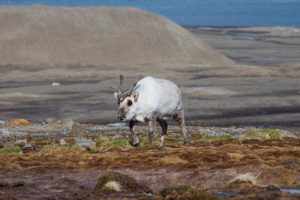
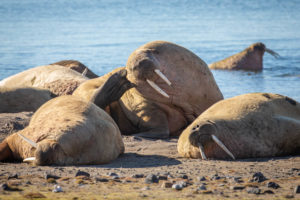
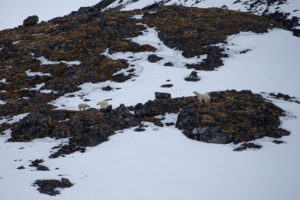

While heavy topics and melting ice underscored the trip, both students appreciated the novelty and majesty of the experience. On most days, the troop would disembark and get close looks at wildlife. Massive walruses piled their leathery skin atop one another. Through laughter, Odufuye recounted how surreal it all was. “I could have just stayed there staring for so long,” she said. Beluga whales and black guillemots cut through dark water as humpbacks breached the surface. There was an overall sense of whimsy; on one excursion, the cohort went sea-kayaking. “It’s going to make me sound like a toddler,” Lansbury said. “I wondered how salty the ocean was up there with all the melting freshwater,” she said. “And I tasted it.” As Lansbury leaned forward to try out the ice chunk, she heard a loud popping noise. Air escaping from the frozen earth rung out like Rice Krispies. Both students wore bright smiles as they recounted the full sensory experience. “The water is not as salty as you think,” Lansbury concluded.
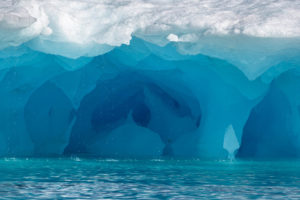
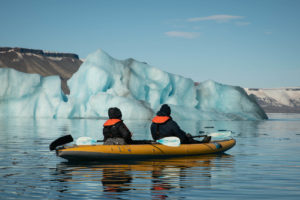
The expedition went far enough north to experience perpetual light. The sun filled every deck of the ship as Lansbury and Odufuye heard talks about climate change from experts and organizers. Researchers from across the planet shared personal stories about the impact of the climate crisis. Lansbury and Odufuye both individually felt more heartened to see the active work that the members of their cohort were doing to combat the crisis. ClimateForce alumni keep in regular contact, and the pair have access to those conversations. Both students said the trip empowered them to do more. However, it was not the everlasting sun or a vague sense of hope that inspired the pair. The specific, pointed efforts of climate leaders made them recognize the need for action.
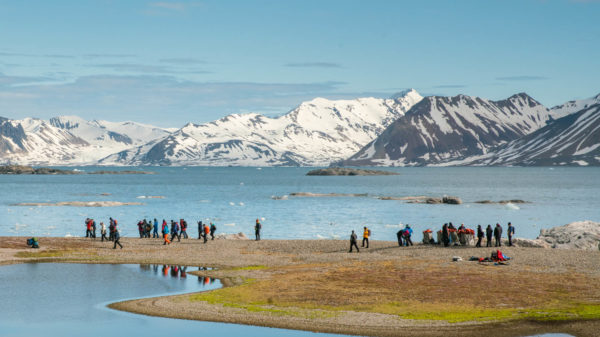
Odufuye took to the idea of storytelling, which was the emphasis of one of the expedition’s workshops. The art student has contacted her former high school about doing a presentation to students on sustainability. She has also reached out to UTeach, a program that combines STEM degrees with a secondary teaching certification, to see whether they can help her connect to middle and high schools in the surrounding area.
Lansbury, who wants to work in policy, was struck by conversations with an English solar panel company owner. She is now researching related legislative committees for which she can intern in her hometown of Washington, D.C.
Both students are grappling with what change looks like in their personal lives and on a global scale.
“You have to be intentional about keeping that inspiration going,” Odufuye said. “I have to constantly remind myself: I can’t just stop there. I have to bring something back.”

